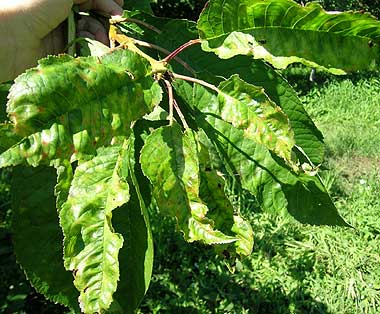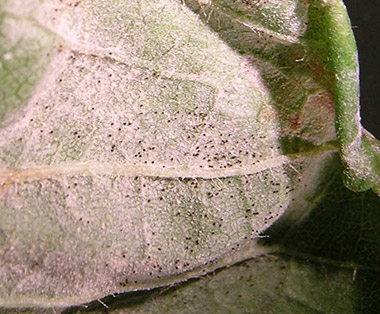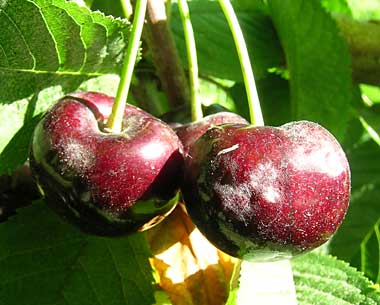Powdery Mildew (Sweet Cherries)
General Description
Powdery mildew of cherry is caused by the fungus Podosphaera clandestina.
Symptoms
On leaves, powdery mildew appears as patches of white, powdery or felt-like fungal growth. Severely affected leaves and shoots are often puckered or distorted (Fig. 1). Cleistothecia (fungal fruiting bodies) appear in older mildew colonies as small, black specks. Leaf infections are usually first observed about 4-6 weeks after bud break, and become increasingly obvious as the season progresses. Young, expanding leaves are more susceptible than mature leaves (Fig. 2). Fruit infection appears as a white powdery bloom as the fruit ripens (Fig. 3), or as roughly circular, slightly depressed areas on the fruit surface with or without any obvious growth of powdery mildew spores.
 |
 |
| Figure 1. Cherry leaves damaged by powdery mildew. (BCMA) | Figure 2. Powdery mildew growth on the underside of a sweet cherry leaf. Note black chasmothecia (overwintering fruiting bodies) |
 |
|
| Figure 3. Powdery mildew damage to sweet cherry fruit, cultivar 'Sweetheart' (BCMA) |
Life Cycle
Powdery mildew overwinters as cleistothecia on leaf litter on the orchard floor, and trapped in tree crotches or bark crevices. Ascospores are released from the cleistothecia in response to rain or irrigation and provide the “primary” or first inoculum that infects cherry leaves or shoots in the spring. In Washington, ascospore release was found to begin one month before bud burst, and continued until after bloom. There is no evidence that cherry mildew survives as mycelium in dormant buds, as occurs with apple mildew. Once mildew colonies have become established, a second type of spore (conidia) is produced. There are multiple generations of conidia produced all summer, potentially resulting in a rapid build-up of inoculum and disease levels. Fruit infection is caused by conidia that are produced on the leaves. Immature fruit is much more susceptible than mature fruit, and susceptibility decreases as sugar content increases. Powdery mildew is favoured by moderate to warm and humid conditions, with optimal temperatures in the range of 15-25°C. Conidia are not produced below 10°C or above 30°C. Mildew severity is greater in years with frequent showers in late spring and early summer.
Management
Cultural Control
1. Prune for good air circulation. Avoid overly dense plantings.
2. Remove infected water sprouts before full leaf
3. Keep grass mowed short to reduce humidity in the orchard.
Chemical Control
Susceptible and late-harvest varieties and problem blocks:
Begin a control program early, no later than bloom to petal fall, to protect emerging green tissue from airborne ascospores. Preventing or minimizing primary infections of foliage is important to prevent fruit infection later in the season.
Continue fungicide coverage until harvest. Adjust spray intervals as needed depending on the rate of shoot growth, fungicides selected and weather conditions. More sprays will be needed in wet years than dry years.
Consider post-harvest application of fungicides to prevent buildup of mildew on foliage and reduce the amount of overwintering inoculum. For these late season sprays it is best to select products that have a low risk of resistance, such as sulphur, bicarbonate or summer oil.
Less susceptible varieties and blocks without a history of mildew problems:
Critical spray timings for fruit protection under conditions of light to moderate mildew pressure include fungicide applications at husk fall and about 7-10 days later to protect the susceptible green fruit.
Fruit is most susceptible to mildew up to the pit hardening stage.
Fungicides registered for control or suppression of powdery mildew on sweet cherry include:
- Flint (trifloxystrobin)
- Cabrio EG (pyraclostrobin)
- Fontelis (penthiopyrad)
- Luna Sensation (fluopyram + trifloxystrobin)
- Nova (myclobutanil)
- Quash (metconazole)
- Quintec (quinoxyfen)
- Vivando (metrafenone).
- Purespray Green Spray Oil 13E (mineral oil) - suppression
- Pristine WG (pyraclostrobin + boscalid) - suppression
- Sirocco (potassium bicarbonate) - suppression
- Sulphur products such as Kumulus and Cosavet are registered for brown rot on sweet cherry, but also provide good control of powdery mildew.
Caution: There is some evidence that resistance to Nova (group 3 fungicide) is developing in cherry powdery mildew. Limit the use of group 3 fungicides to 1 or 2 per season and alternate fungicide groups.
Research in Washington has shown that lime sulphur applied to sweet cherry trees in the fall may be useful to reduce the overwintering population of the fungus. This will not eliminate the need for fungicides during the growing season, but reducing initial inoculum will help to delay the build-up of disease levels and make fungicidal control more effective. Fall application of lime sulphur was found to be more effective than spring application in Washington State. In Canada, Lime Sulphur is registered on cherry as a “general clean-up” dormant spray, as well as for San Jose scale, European scale and mites.
Updated July, 2018
